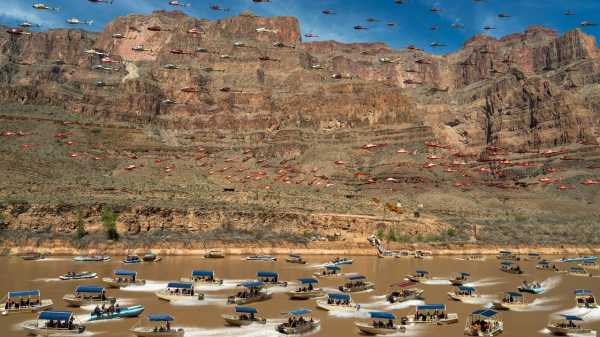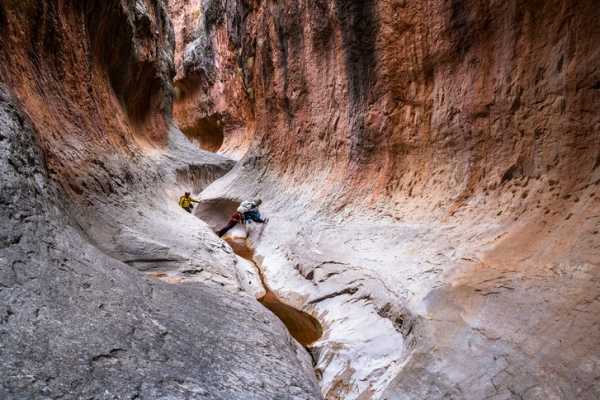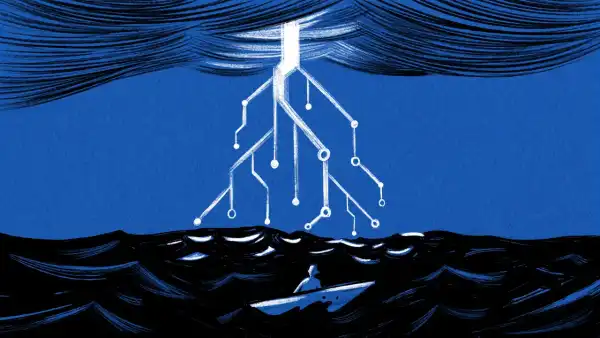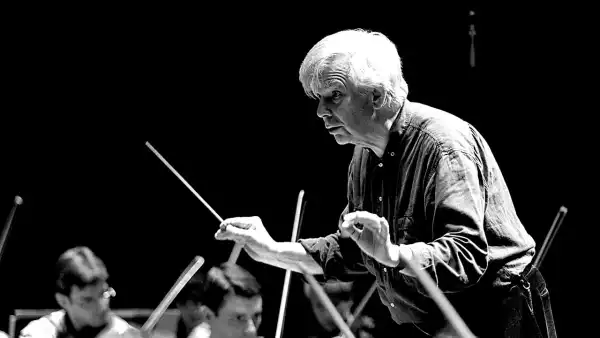
Three years ago, in the course of thirteen months, the photographer Peter McBride and the writer Kevin Fedarko hiked from one end of the Grand Canyon to the other. They did it in eight sections, mainly so that McBride could shoot in different seasons. In all, it took them seventy-one days to cover two hundred and seventy-seven river miles and some eight hundred shoe-leather miles, through some of the continent’s roughest hiking terrain—“a whole lot of scratching around the rock puzzles in that giant abyss,” as McBride put it recently.
Before they set off, the Grand Canyon had been hiked nose to tail only nine times in recorded history. There is also a handful of obsessives who have chipped away at it, piece by piece, in the course of decades. “Maybe some crazy ancestral Puebloan did the whole thing, but that wouldn’t make logical sense—they wouldn’t have had any reason to,” McBride said.
McBride, a native Coloradan who shoots for National Geographic, has been documenting the Colorado River for a decade, sometimes from a perch in an ultralight aircraft. Fedarko, who lives in Flagstaff, Arizona, has guided on the river and is the author of “The Emerald Mile,” an account (with many historical tributaries) of a harrowing speed run of the Grand in a dory during the biggest flood in generations. (As it happens, Kenton Grua, the boatman in the book, was also the first person to walk the canyon, in 1976.) McBride and Fedarko have both become persistent, ardent advocates for preserving the place, in all its spellbinding, inhospitable glory, in abidance with Teddy Roosevelt’s famous dictum, issued during his one visit, in 1903: “Leave it as it is. Man cannot improve on it; not a bit.” Still, this was the first time, and surely the last, that either of them had tried to walk it.
On the trek, they each carried packs that averaged about fifty pounds, containing eight days or so of food, as much water as they could hold, and not much in the way of accommodations. They carried a plastic syringe to draw water from potholes in the rock. McBride carried just one camera, one lens, and a solar charger; on cold nights, he kept the batteries warm in his armpit. The temperature ranged from a hundred and twelve degrees Fahrenheit to five degrees. There were hardly any trails, save for those made by game. “Sheep shit was our G.P.S.,” McBride said. They climbed over a hundred thousand vertical feet. “We went through seven pairs of shoes, four ankles”—they each sprained both—“and two girlfriends” (both McBride’s). There were broken fingers, and surgery to remove a cactus spine. McBride, still a bull of a man at forty-seven, lost thirty-five pounds, and, just five days into the first leg, nearly perished of hyponatremia, salt depletion from over-hydration, which is the leading cause of death in Grand Canyon. Once the project was complete, he needed heart surgery.
McBride, whom I’ve known for many years, had invited me to accompany him on a stretch or two. Fortunately, I had ways to say no. When I turned forty, almost a decade ago, I spent more than two weeks floating the Grand on an unguided raft trip with a group of friends. Not unlike many others who’ve been there, I found it to be just about the most spectacular, humbling place I’d ever been; words or pictures can’t convey the scale. I also discovered that the hiking—up drainages and slot canyons, along cliffs and waterfalls—was often more perilous than paddling the rapids. One day, while I was shuffling quickly and dizzily along an exposed ledge, an unseen overhang caught my shoulder and nearly spun me off the edge and into a ravine. Hiking! Who knew?
This month, in advance of the park’s centennial next year, Rizzoli is publishing a book of McBride’s photos, called “The Grand Canyon: Between River and Rim.” Fedarko, in an introduction, calls it a “a visual requiem.” It aims to capture not just the familiar grandeur but also some of the fragile idiosyncrasies of the between-lands, as an argument for leaving them alone.
“There’s been a thousand books of the Grand Canyon made with pretty pictures,” McBride said. “Our goal was to show how the place is changing. And our trip was more about immersion in the place than an A-to-B, let’s-go-conquer-it glory hunt. People tend to visit the rim or the river but rarely spend much time in between.”
One photograph, which achieved some Instagram renown, in 2016, captures a sense of a canyon at risk. Against a backdrop of cliff and sky, some hundred and fifty helicopters and several dozen motorboats clog a couple hundred yards of canyon—it’s gridlock in “Heli Alley.” The shot is unambiguously a Photoshop merge, a composite of hours of sightseeing traffic (for this reason, National Geographic declined to publish it, when it ran their story about the trip, but it’s still astonishing, even appalling, to gaze upon this aggregation of noise and exhaust).
Sixteen years ago, there were virtually no helicopters. Now there are as many as five hundred flights a day. On the day that McBride made the photograph, he counted three hundred and sixty-three. “This has happened under our nose,” he said. “The government could stop it, but they don’t want to pick a fight with the Hualapai.”
The downstream end of the park abuts land belonging to the Hualapai tribe. The exact boundary is in dispute. The Hualapai collect landing fees on the helicopter flights. The F.A.A. granted the Hualapai a hardship exemption from the cap on the number of flights. The Hualapai now bring in more than a million visitors a year. Among other things, they commissioned and own the Grand Canyon Skywalk, a cantilevered glass-floored platform on the south rim, and have considered reviving an old mining tramway to deliver tourists to the river. The sightseeing boats and helicopters take in tens of millions of dollars, though McBride was told that most of the proceeds go not to the tribe but to a handful of outfitters in Las Vegas. “The helicopter problem has divided the tribe,” McBride said.

A panoramic view of the confluence of the Colorado and the Little Colorado.
Photograph by Pete McBride
Another photograph, which provides the book’s cover, depicts a pristine corner of the park that is now in great danger of becoming even more of a clusterfuck than Heli Alley. This is the confluence, not quite two hundred miles upstream, of the main Colorado River and the turquoise waters of the Little Colorado River. A wedge of the land at the union of the two rivers is claimed by the Navajo Nation, which had partnered with some Scottsdale investors to build a billion-dollar project—a tramway that would deliver as many as ten thousand tourists a day from the rim down to a visitors’ complex, which would include an amphitheatre and a restaurant—in what is now a kind of desert Eden that has long been a sacred place to the Navajo, the Hopi, and also, in a different sense, to anyone who has managed to pass through there, by boat or on foot.
Last fall, the Navajo Nation Council voted against the plan, but, according to Fedarko, the developers were back on the reservation the next day, cultivating new political allies who might vote differently if and when the plan, which its Navajo opponents call a “zombie,” rises again. (There’s a Navajo presidential election in November.) The pro-tram argument is that it would provide the Navajo with revenue they deserve and need, and also would allow more taxpayers and tourists to experience the canyon floor—people who would otherwise be incapable of getting there on their own, owing to physical disability, a lack of fitness, or plain old faintheartedness. But there are plenty of ways for, say, the elderly and the disabled to get down to the river in other places. One worry, among advocates like McBride and Fedarko, is that, if some version of this tram plan ever succeeds, it will be a staging ground for tourist helicopters, which would in turn also be used to airlift motorized boats up to the rim, so that they could be conveyed back upriver to Lee’s Ferry, at the head of the canyon. This would enable an endless loop of motorized-raft day trips, from Lee’s Ferry to the Little Colorado. “It’s a horrific vision,” Fedarko says. “Absolutely horrific.”
Time was, the canyon was a busy place. “The Puebloans were everywhere down there, and they knew it better than we could possibly imagine,” Fedarko said.
“You’re walking through a living museum,” McBride said. “There are artifacts everywhere. Like, carpets of pottery shards. We were in places that maybe no one else has seen.” There’s a photograph in the book of some polychrome pictographs, which are said to be more than four thousand years old. The paintings stretch for sixty yards and are twelve feet tall.
“What happened to all these people?” McBride asked. “Well, they’re still here. They’re living on reservations on all sides of the park. Some of them are all for development, some are against it.” He has a photo in the book of some Havasupai in traditional dress protesting at a uranium mine. “The tribes have to be included in the conversation. If we’re not working with them, we get another Helicopter Alley.”
There has always been tension, in our national parks, between those who advocate access and ease, on the one hand, and those who prize wilderness preservation and hard-won immersion, on the other. Sometimes the proponents of access are merely dressing up greed in the garb of democracy; gift shops and hotels are less about the people than the proceeds. But it is also true that to get to a place like the confluence, you need gear, vigor, and time—which, fairly or not, are occasionally considered to be proxies for privilege. Still, there are a host of other threats to the Grand Canyon that do not raise such questions of caste: a vast Italian real-estate-development scheme on the south rim, an array of uranium mines and claims that, among other things, threaten to pollute the aquifers that eventually drain into the Colorado. (When one of them flooded last year, the mitigation involved spraying the possibly contaminated water into the air with snowmaking guns. Another horrific vision.)

Hiking in the Grand Canyon can be a perilous pursuit.
Photograph by Pete McBride
The National Park Service has mostly done an elegant job in the Grand Canyon. The float-trip lottery system insures that tens of thousands of people get to paddle the river every year, under the illusion that they are utterly alone. The designated campgrounds get used hard, yet, for the most part, they feel like deserted islands. And there’s more going on, in the in-between, than the river-runners might see, hear, or think. The Grand Canyon has a wider range of biodiversity than any other national park, due to the range of habitats that exist along the vertical axis of this six-thousand-foot abyss. There are supposedly species of bird that don’t migrate. They just change rock layers, season to season.
There are more layers of rock than there are letters in the alphabet. The youngest, the Kaibab limestone, at the rim, is two hundred and fifty million years old, which postdates the end-Permian extinction, known as “the great dying,” a couple of mass extinctions prior to the one we are hastening now. The oldest stratum, at around two billion years old, is the Vishnu schist, a primordial black bedrock rubbed smooth, like Darth Vader’s helmet. The sight (and contemplation) of it is a bracer to beered-up rafters, as they ooze through the earth’s basement.
“We’re mere specks in the timeline,” McBride said. “Maybe we Americans need to hear this more often. The canyon delivers a message of humility.”
He went on, “Obviously, the current Administration doesn’t give a rat’s ass about any of this.” Last fall, he and Fedarko gave a presentation to the Secretary of the Interior, Ryan Zinke, along with members of his department, the board of the National Park Foundation, and some Grand Canyon park officials. Afterward, McBride wrote in an e-mail to friends, “The audience kindly gave us a standing ovation (Zinke stood last) and afterwards a Hopi elder thanked us and then asked the Secretary to protect ‘our sacred landscapes and the Canyon.’ The secretary never took his gaze off the ground when the Hopi elder spoke, so I don’t know what he heard.”
“We all think the Grand Canyon is protected, but in fact it’s not,” McBride said, last week. “It’s a generational challenge.” Fifty years ago, preservationists narrowly defeated a plan to dam up a couple stretches. It’s not hard to imagine that someone might want to try it again. But the clear and present danger, right now, is men and machines.
“We think of the Grand Canyon as a marvel of texture of landscape,” McBride said. “I do, anyway, as a photographer. But I found that the defining element is silence, a kind of liquid silence. It was so quiet that the mikes on my camera would buzz, because they were calibrated to a noisier silence. Now I realize how noisy the world is.” More than ever, maybe, we need an escape from it.
Sourse: newyorker.com






